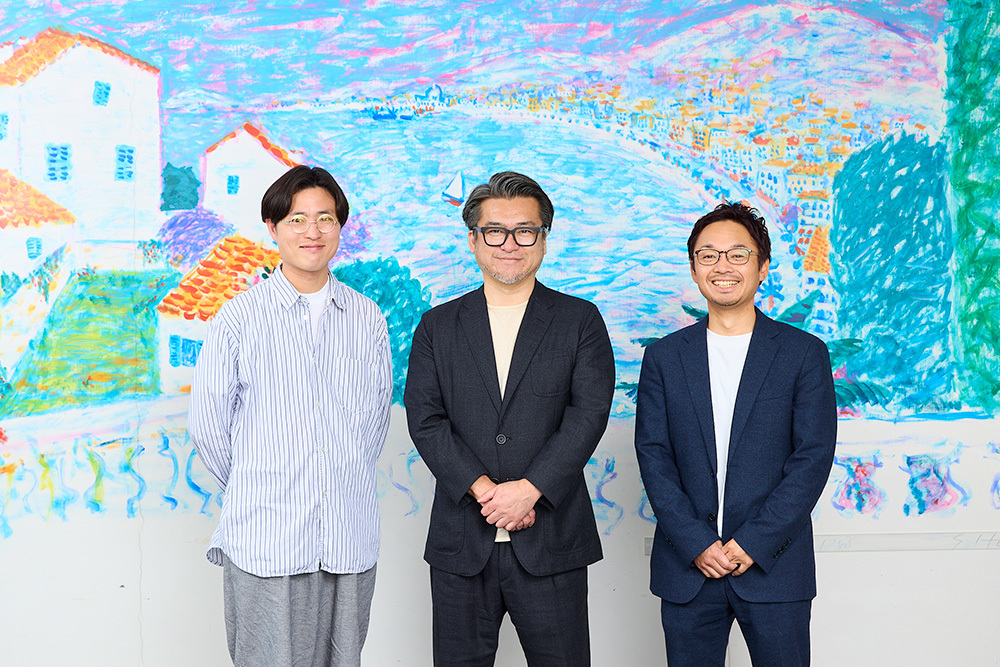Note: This website was automatically translated, so some terms or nuances may not be completely accurate.
Why did the magazine "BRUTUS" succeed with "video"?
The creative power and brand strength cultivated by publishers through magazine and book production are now gaining attention. This series will introduce publishers' assets and content creation for today's era across various themes, offering insights for marketers on how to leverage the publishing industry.
The first theme is "Video." With more media outlets focusing on video content these days, what is the video strategy being pursued by publishers? We introduce the efforts of "BRUTUS," a magazine within Magazine House that was quick to focus on video initiatives and achieved success.
Our guests are Mr. Akira Tajima, Editor-in-Chief of BRUTUS magazine, and Mr. Isao Cho, Head of Magazine House's Business Production Department. The interviewer is Mr. Kazuki Nakamura from Dentsu Publishing Business Development Division (hereafter Publishing BP Division), which develops digital solutions including video.
Magazine House
A leading Japanese publisher handling a wide range of publications including the periodicals anan, POPEYE, Croissant, BRUTUS, Tarzan, Hanako, GINZA, CasaBRUTUS, ku:nel, and &Premium, as well as books, mooks, and web magazines.

Video will be a crucial tool for rebuilding the magazine business ecosystem
Nakamura: First, please introduce yourselves.
Tajima: I've served as Editor-in-Chief of BRUTUS since December 2021. As an Executive Officer, I also discuss brand strategies for Magazine House's ten regularly published magazines with the editorial officers in charge of each title. I'm involved in planning and operating the anniversary events this fall for Magazine House, which celebrates its 80th anniversary this year.
Naga: As head of the Business Production Department, I work directly with advertisers to maximize advertising revenue across Magazine House's various media platforms. Concurrently, I drive the company's digital transformation (DX). I also belong to the New Business Development Department, where I contribute to initiatives for Magazine House's 80th anniversary and the development of new business ventures.
Nakamura: Today, we'd like to discuss the theme of "Publishers × Video." Video is currently booming. Looking at Japan's 2024 advertising expenditure, "video advertising" recorded the highest growth rate among ad categories at 843.9 billion yen, a 123.0% increase year-on-year. Its share of total advertising expenditure reached 28.5%, surpassing display advertising (25.8% share) for the first time since estimates began.
Reference Article
"2024 Internet Advertising Media Expenditures" Explained: Video Advertising Growth Accelerates Further; Social Advertising Expenditures Surpass ¥1 Trillion
We at Dentsu Inc. Publishing BP Bureau regularly work with Mr. Tajima and Mr. Cho. Magazine House has also seen a significant increase in video projects, hasn't it? Could you tell us why your company is focusing on video?
Naga: Video has become extremely important for publishers. Let me explain the background first. The publishing market is heavily influenced by magazine and book sales, but now, due to consumers shifting to digital, bookstores are rapidly disappearing.
What surprised me most when I joined a publisher—or rather, what I realized was the core strength beyond content—was the power of distribution. Once you create a book or magazine, it's immediately distributed nationwide and sold in bookstores. This is something rarely possible for typical manufacturers. I believe the robust distribution system built by our predecessors, distributors, and bookstores underpinned the strength of publishers.
Nakamura: You say "supported," implying it's changing now.
Naga: Yes. While the factors supporting a publisher's sales can be broken down in various marketing ways, I believe what we should focus on beyond content is the "stocking rate" (the probability a title is available in stores) and the "recognition rate" of books and magazines. However, due to consumers' digital shift, we're now caught in a negative cycle: fewer bookstores → reduced stocking → lower recognition → declining sales → fewer bookstores.
So even if we create great content, it doesn't reach consumers as effectively as before, making it harder to drive sales. As publishers face challenges like a shrinking market, declining media influence, and reduced advertising revenue, we need to consider how to improve not only advertising sales but also the core distribution rate and awareness rate that support our sales profits.
That said, distribution rates face the challenge of declining bookstores, making immediate improvement through individual company efforts alone difficult. However, we believe there are ways to deliver content more effectively to consumers. We have advanced digitalization, for example, by enhancing our magazine websites.
Currently, social platforms attract the largest user base. As these platforms prioritize advertising monetization, user dwell time and engagement are likely their most critical metrics. Video appears to be considered the most effective format for this, and I believe algorithms are increasingly prioritizing video delivery, especially to new users.
Considering that social platforms will increasingly shift toward video, to boost distribution rates and awareness, we must not only create magazines and books but also learn and hack the algorithms of social platforms to make our content more discoverable.
Nakamura: So, to rebuild the magazine business ecosystem, reach is crucial, and video is becoming an essential tool for achieving that.
Naga: Exactly. That said, even knowing video is important, I believe it's actually quite a high hurdle for companies that aren't content creators to start from scratch. In that regard, since we are a company constantly creating content, I think there are various things we can do. By establishing a good routine for video production as an extension of Magazine House's content creation, can't we strengthen our ability to deliver content? That's why we consider video important now, both for magazine sales and advertising sales.

Video initiatives led to more sold-out issues of BRUTUS
Nakamura: Next, let's discuss BRUTUS's video initiatives. BRUTUS launched its video campaign "BRUTUS ORIGINAL MOVIE" in May 2023, correct? What kind of content is it?
Tajima: It's a video series spun off from BRUTUS features. Each issue delivers videos designed to enhance enjoyment of the feature through perspectives unique to video. Among Magazine House's publications, BRUTUS has been spearheading and actively pursuing video initiatives.
Nakamura: Among all Magazine House's publications, why did BRUTUS take the lead?
Naga: To begin with, even saying we'd implement video initiatives at Magazine House wasn't going to be smooth sailing. After all, many people became editors because they wanted to make print (magazines), so the atmosphere wasn't immediately one of "Let's do video."
Given that environment, we identified two key points from a business perspective. First, we needed to create a video that achieved significant commercial success. We knew merely generating some buzz wouldn't change the internal mindset. Second, we had to select a magazine from Magazine House's ten regular publications where video initiatives would be most effective. Crucially, this meant choosing a magazine where a robust video production support system could be quickly and properly established.
Considering these two points, we concluded BRUTUS was the best choice. Editor-in-Chief Tajima had long recognized the importance of video, so we anticipated his proactive involvement. Regarding the structure, since BRUTUS lacked dedicated video staff, we assigned external personnel. This created a system where they primarily worked for BRUTUS while also advising other brands.
Nakamura: How did the editorial staff react when you started video?
Tajima: Well, it wasn't exactly a smooth "let's do this" kind of feeling... (laughs). Video production wasn't their specialty, and it meant extra effort and increased workload. So, I kept explaining "why we're doing video" and saying, "As editors, tackling video as a field alongside print will absolutely broaden your content expression and be fun." That's how I got the editorial staff on board.

Naga: When creating video content, we discussed what makes a "BRUTUS-like video," right? We concluded that "releasing various features every two weeks is the very essence of BRUTUS."
So, we reasoned that creating original videos aligned with our feature themes would ensure a biweekly upload. Since BRUTUS covers such diverse topics, this approach would generate varied reference materials, making it appealing to a wide range of industries and companies for advertising.
Tajima: We were careful about something when making videos. The typical approach treats video as promotional material to sell the print (magazine). For example, it often means bringing the video team to print shoots, rolling cameras during breaks, and introducing the feature like, "This is what we're covering this time." That approach keeps video perpetually in a subordinate role to print.
So, I asked the editorial staff to approach each feature theme with the mindset: "This concept will be expressed in print," or "This one will be shown through video." As a result, the video content ended up featuring original concepts never covered in print at all. The idea was to create a mechanism where readers could enjoy the feature theme more fully by experiencing both the print and video versions.
Nakamura: What kind of projects were there, for example?
Tajima: We once did a horror feature. Honestly, I'm scared of scary stuff, so I'd been avoiding doing a feature on it (laughs). But then I heard about the recent boom in ghost storytellers from a new generation. After watching some videos, I saw how various storytellers, in different settings, brought originality to their delivery, elevating it into high-quality entertainment. I found that fascinating. So, before planning the magazine feature, I came up with the idea to create a video series like a THE FIRST TAKE version featuring ghost storytellers.
So we made the video, and for the print edition, we included a sealed insert with a "cursed ghost story" that hadn't been published anywhere else. The result? The video racked up incredibly high view counts. This gave the editorial staff creating the content a real sense of accomplishment, making them truly appreciate how interesting print-video collaborations can be. This created a positive cycle: they started actively proposing ideas, and their video planning skills improved. Now, all editorial staff are comfortable with video and feel confident in developing solid concepts from the planning stage.
Nakamura: That's exactly what Nagasawa aimed for. Are you seeing the effect of creating videos on magazine sales?
Tajima: It's hard to isolate the impact of video alone on sales, but we definitely feel it contributes when combined with regular promotions. For example, the BRUTUS 1000 commemorative issue sold out because we focused heavily on video and ran various promotions.
It's been just under two years since we started video initiatives, and beyond commemorative issues, BRUTUS is selling out more often. We're also frequently exceeding our sales projections for features, thinking "this special feature should sell about this many copies."
Nag: While there's talk about marketing strategies to sell magazines, ultimately, I feel we win when the editorial team starts enjoying the process. BRUTUS's success has led to more magazines like anan and POPEYE investing heavily in video initiatives.

The logo is a magazine's most important asset
Nakamura: So, what exactly is the appeal of the videos created by BRUTUS and Magazine House?
Tajima: This applies to print too—it's about not just shooting conventionally, but the originality born from brainstorming and exploring diverse ideas. Their videos match print in the level of effort and idea integration, ensuring the creative tone remains consistent. Crucially, print editors actively participate in video production. They don't outsource everything to the video team; instead, they value a collaborative process where video directors and print editors exchange ideas as equals to shape content.
Nakamura: When it comes to ensuring the print worldview in video, the value of the logo can't be overlooked, right?
Naga: Exactly. We position the logo as our most important asset. With fewer bookstores, opportunities to see magazine logos have drastically decreased. This risks magazine brands fading from consumers' minds. To prevent that, exposing the logo on the most-used social platforms is crucial for boosting recognition. That's why we have a rule in video production: the logo must always be placed in a highly visible spot.
Nakamura: I believe logos are also crucial for advertisers. After all, the logo is the clearest way to communicate that their product is being featured in BRUTUS.
Precisely because anyone can create videos now, "who creates it and who distributes it" becomes extremely important. Advertisers allocate precious budgets for their ads, so there's significant value in partnering with entities that have brand history and trustworthiness.
Hearing about BRUTUS this time really helped me see the power of videos created by publishers. Next time, I'd like to broaden the conversation to other Magazine House publications and learn about their video initiatives.
Was this article helpful?
Newsletter registration is here
We select and publish important news every day
For inquiries about this article
Author

Akira Tajima
Magazine House Co., Ltd.
Executive Officer, Third Editorial Bureau Chief, Editor-in-Chief of BRUTUS
Joined Magazine House in 1997 and was assigned to BRUTUS in 1998. Became Deputy Editor-in-Chief in 2010. Appointed Editor-in-Chief of Hanako in 2016, producing brand expansion initiatives including product development and creative label ventures. Appointed 11th Editor-in-Chief of BRUTUS in December 2021. Currently serves concurrently as Executive Officer of Magazine House, Third Editorial Bureau Director (Publisher of BRUTUS and Tarzan), and Editor-in-Chief of BRUTUS.

Naga Isao
Magazine House Co., Ltd.
Business Production Department Manager / New Business Development Department
After working at an advertising agency, joined Magazine House in 2017. Engaged in the Business Production Department, which tackles advertiser challenges and develops new solutions with editorial teams, and in company-wide DX promotion.

Kazuki Nakamura
Dentsu Inc.
Publishing Business Development Division Digital Content Planning Department
Planner
After joining the company, I have consistently handled publishing-related duties, including magazine advertising, promotional activities for publications, digital magazine operations, and digital business development for publishers. Currently, I continue to focus on the theme of "Publishers × Digital," developing solutions to address advertisers' challenges.



